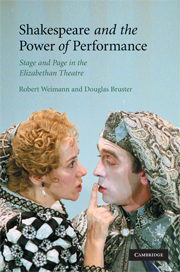Book contents
- Frontmatter
- Contents
- Acknowledgments
- Introduction
- Chapter 1 “Moralize two meanings” in one play: contrariety on the Tudor stage
- Chapter 2 Performance, game, and representation in Richard III
- Chapter 3 Mingling vice and “worthiness” in King John
- Chapter 4 Clowning: agencies between voice and pen
- Chapter 5 Clowning at the frontiers of representation
- Chapter 6 Cross-dressing and performance in disguise
- Chapter 7 Personation and playing: “secretly open” role-playing
- Chapter 8 Character/actor: the deep matrix
- Chapter 9 Character: depth, dialogue, page
- Chapter 10 King Lear: representations on stage and page
- Notes
- Index
- References
Chapter 2 - Performance, game, and representation in Richard III
Published online by Cambridge University Press: 22 September 2009
- Frontmatter
- Contents
- Acknowledgments
- Introduction
- Chapter 1 “Moralize two meanings” in one play: contrariety on the Tudor stage
- Chapter 2 Performance, game, and representation in Richard III
- Chapter 3 Mingling vice and “worthiness” in King John
- Chapter 4 Clowning: agencies between voice and pen
- Chapter 5 Clowning at the frontiers of representation
- Chapter 6 Cross-dressing and performance in disguise
- Chapter 7 Personation and playing: “secretly open” role-playing
- Chapter 8 Character/actor: the deep matrix
- Chapter 9 Character: depth, dialogue, page
- Chapter 10 King Lear: representations on stage and page
- Notes
- Index
- References
Summary
To move from a late moral play to Shakespeare's first tetralogy is to encounter a puzzling hiatus. This hiatus divides the moral interludes and related dramatic medleys of the 1560s and 1570s from the new and startling impetus coming from Kyd and Marlowe in the second half of the 1580s. Never sufficiently accounted for, the space between these types of plays, and between their dates of composition, bears significantly on the emergent Elizabethan relations of page and stage. Grappling with the terra incognita of these years, theatre historians, particularly in the wake of Janet Loengard's work on the Red Lion theatre, have encountered a marked “disparity between theatrical activity and printed texts,” where the extremely small number of extant texts sits uneasily with widespread flourishing of performance practices. As we know, regular stagings of amphitheatrical shows for large audiences occurred not only after the opening of the Theatre (1576) and the Curtain (1577) but even a decade earlier, with the setting up of the Red Lion (1567). Recent work in theatre history has given us a cultural landscape that, even when tantalizingly obscured, prompts new and pertinent questions.
Up to a certain time, the history of dramatic literature (the work of such authors as, for example, Nicholas Udall, Richard Edwards, George Whetstone, and George Gascoigne) was largely discontinuous with itinerant and nonacademic shows. These shows clearly proliferated prior to the Shakespearean stage.
- Type
- Chapter
- Information
- Shakespeare and the Power of PerformanceStage and Page in the Elizabethan Theatre, pp. 42 - 56Publisher: Cambridge University PressPrint publication year: 2008

